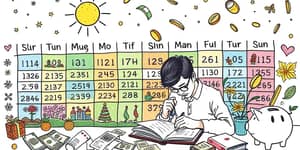
Habits form the backbone of personal growth, guiding us toward healthier lifestyles, increased productivity, and lasting change. Yet sustaining momentum can prove challenging when progress feels invisible. By harnessing the power of visuals, you gain a tangible record of your efforts, creating a feedback loop that fuels determination. In this article, we explore why visual tracking works, the tools to leverage, and practical strategies to ensure your new routines become second nature.
The habit-tracking industry has witnessed explosive growth. The global market for habit-tracking apps soared to $11.42 billion in 2024 and is projected to exceed $13 billion by 2025. Meanwhile, the specific niche of habit trackers alone reached $44 million in 2023, poised to climb to $63 million by 2031 at a CAGR of 13.21%. These figures underscore an increasing user dependence on digital and visual solutions for personal development.
As more people recognize the value of measurable progress, developers race to offer new features: streak calendars, trend graphs, completion indicators, and gamified incentives. This surge in functionality reflects a broader desire to embrace data-driven self-improvement and to transform abstract goals into concrete, visual milestones.
Visual cues hold immense sway over human motivation. When you see a growing chain of completed days, your brain registers a sense of accomplishment that verbal affirmations or checkboxes cannot match. The simple act of marking off a day on a calendar triggers reward pathways, reinforcing consistency even on days when enthusiasm wanes.
Researchers have demonstrated that individuals who track behaviors—whether food intake, exercise sessions, or meditation practice—are statistically more likely to achieve their objectives. One study of over 1,600 participants found daily food loggers lost twice as much weight as non-loggers. By providing visual proof of hard work, tracking tools transform fleeting intentions into enduring habits.
Choosing the right visual tracking method depends on your goals and preferences. Here are the most effective formats:
Whether you prefer a simple paper calendar or a sophisticated app dashboard, integrating multiple visual formats—calendars, graphs, and percentage indicators—provides a multi-dimensional habit tracking experience that caters to both big-picture reflection and granular analysis.
Quantitative research consistently validates the power of visual tracking. In goal-oriented programs for smoking cessation, weight loss, and blood pressure reduction, trackers outperform non-trackers by significant margins. Participants who log their activities report higher satisfaction and maintain improvements longer after formal programs end.
Qualitative studies highlight how visuals boost self-awareness. Individuals often overestimate their consistency; seeing actual performance data dispels illusions and fosters accountability. Small wins become undeniable when displayed prominently, generating positive feedback loops that sustain effort through challenging phases.
Forming a habit typically requires between two and eight months of consistent practice, depending on complexity and individual differences. During this period, motivation naturally fluctuates. Visual trackers act as motivational anchors, reminding you of your progress when enthusiasm dips.
Understanding this timeline sets realistic expectations. Rather than expecting overnight transformation, you learn to celebrate incremental gains and trust the process. Each marked day becomes a stepping stone, gradually shifting behaviors from conscious effort to subconscious routine.
By following these guidelines, you harness the full potential of visual tracking. The accumulation of days, sessions, and data points transforms abstract ambitions into concrete evidence of your efforts, fueling further progress.
Visual habit tracking represents a fusion of psychology, technology, and personal development. As the market expands and research continues to endorse its impact, adopting visual tools has never been more accessible or effective. Whether you aim to meditate daily, learn a new instrument, or improve your fitness, recording progress in vibrant, tangible formats creates a compelling narrative of achievement.
Embrace the visual revolution in habit formation: start marking your days, chart your metrics, and watch as each colored streak and rising graph propels you toward the person you aspire to become.
References













